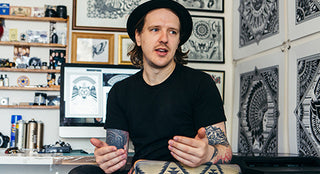As well as being a literary gawd and curator of sonic heat for The Hundreds, ya boy’s day job is within the realm of design and creativity. Being freelance, I know firsthand how tough it can be getting your personal brand off the ground, and it’s something that takes years of blood, sweat, tears and fire tweets to establish. Intrinsic to this struggle, however, is the unique journey and accompanying stories that come hand-in-hand with being daring enough to embrace this fucked up (yet inherently rewarding) lifestyle — and I love nothing more than speaking to fellow creatives about their trials and tribulations, and reassuring each other that we’re not completely insane.
I recently had the chance to sit down with Tom Gilmour — a guy who’s work I’ve been in awe of for several years now — and spent a good few hours at his home studio in South London, chopping it up and generally geeking out over his seemingly endless to-do list, work ethic and commitment to the hustle. Below is an abridged version of our conversation, taken from an hour-long recording that barely fitted onto my iPhone. Hopefully you’ll be left feeling as inspired as I did afterwards.
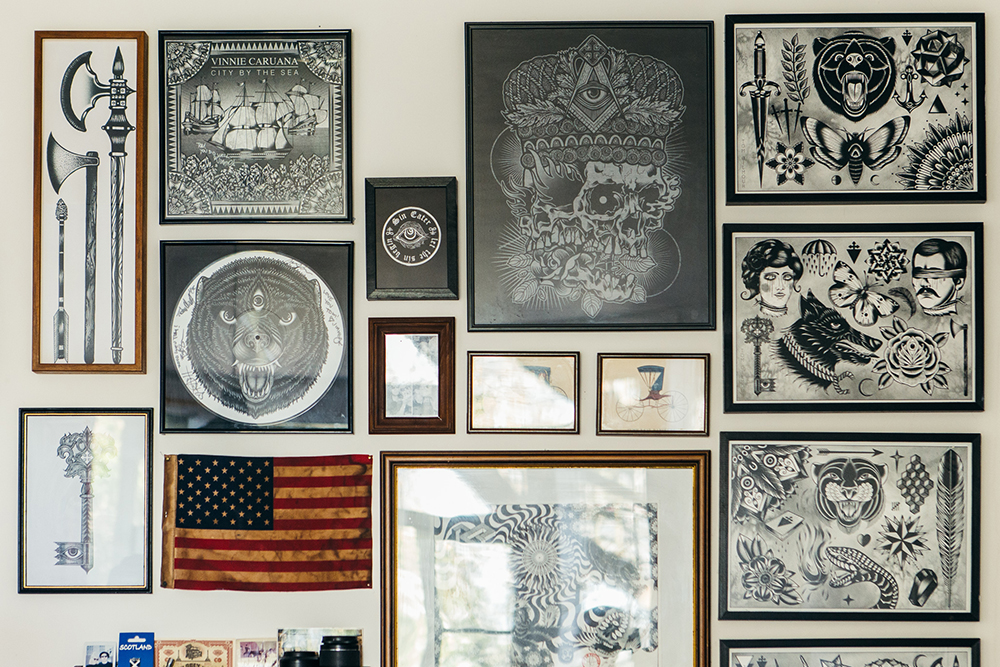
TOM WINSLADE: We’re here in your home studio today. Your natural habitat. Do you want to describe your working environment and how you use it to get yourself in the zone?
TOM GILMOUR: I’ll normally grab a coffee and stick on an episode of Seinfeld or something while I’m getting set up in the morning. I never really attempt any drawing in the AM, it’s normally just emails, catching up with things online and looking at my ridiculous to-do list to plan out my afternoon. Sometimes I’ll work through from then until like 5am or so, it just depends if I get into a flow. Some days can be slow on the creative side of things, so when I have it, I need to stay in that zone until I’m done.
I suppose because you’re working within your home space, you can afford to be quite flexible and laid back with your routine too, which can be both positive and negative.
Yeah, it is quite laid back. Like, when I’m drawing I can stick on a film in the background or whatever and focus on my work without any outside distractions. Even if I my phone rings or an email pops up, unless it’s super important, I’m not going to disrupt my work flow by answering or replying. I guess it becomes a little sanctuary for me in that sense. It changes all the time though. Some days might be more focussed on emails and planning rather than actual design work. It’s nice to have that flexibility.
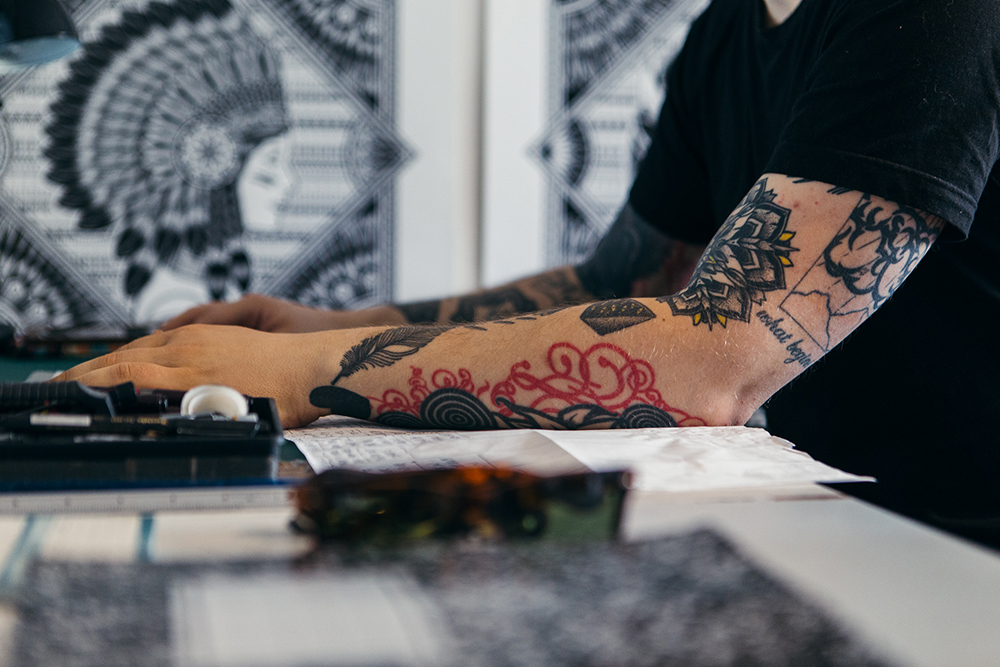
How do you find living and working in London? Have you lived here your whole life?
I grew up in Slough, so like, 20 miles out of London. Then I lived in Reading for about 5 years before I ended moving into London itself. Once I got here though, I feel like I began to adopt this mindset which I think is true for creatives living in all major cities – London, LA, NYC or wherever – which is basically you have to do well, otherwise you’re homeless. I mean, it’s almost good that the rent prices are insane because it pushes you to work as hard as possible. So living in London is good in that sense alone, because everyone’s hustling.
It’s constantly moving and changing too.
Yeah, I mean, living in a city like this is awesome in so many ways. For example, if my heads frazzled after working all week, I can just jump on the train and go to an exhibition in Shoreditch, or go meet a friend in another part of the city and get inspired there. There’s also the whole networking side of things too, as cliché as that sounds, and as much as you can do it online, the potential for picking up contacts just from being in the city is endless. There’s much more personality to those encounters too, as opposed to emailing someone out of the blue and it coming across as sterile. Putting yourself in an environment where people can meet you in person and find out that you’re not an asshole will always be a far better approach.
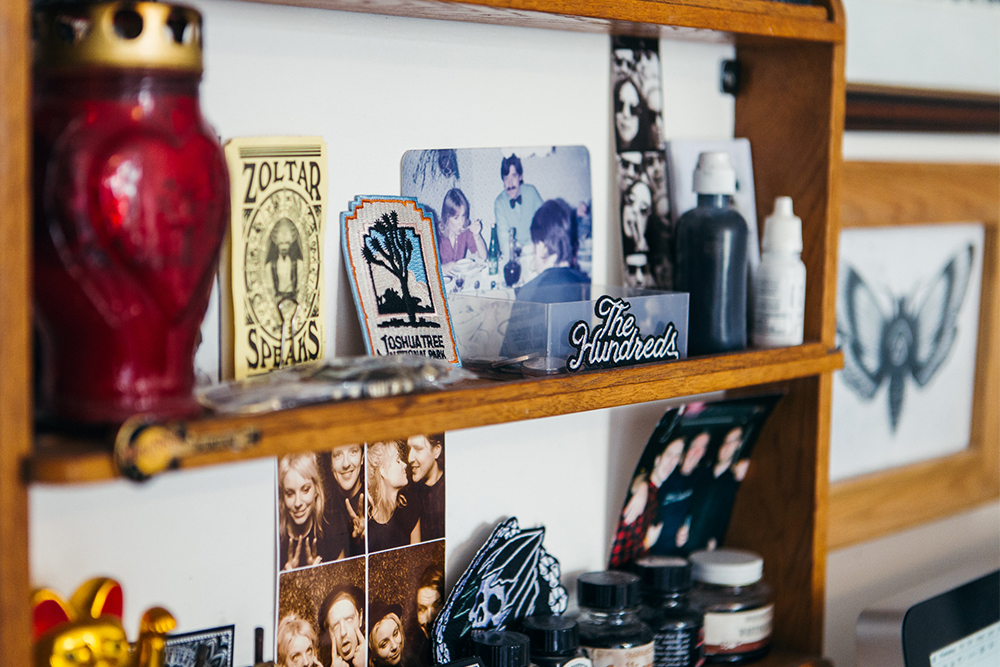
It’s an experience that you wouldn’t get elsewhere in the UK too. Perhaps some of the other major cities, but in London in particular you have people from so many cultures and backgrounds clashing together. It’s completely unique.
It’s very cosmopolitan.
Yes, that’s the word! What I’m trying to get at is, would you say that by living here in particular it’s helped you to develop your style of work, and your general lifestyle too?
Yeah, definitely. If I track back into my history a bit, I spent two years at the Surrey Institute of Art & Design studying Graphic Design & New Media – which is where I learnt all the tools, but I was never really that inspired. After that I worked at a bar for a bit, but that was obviously even less inspiring, so I went an looked for a job in design to follow that. I ended up getting a job as a graphic designer in – get ready for this – a travel agent’s designing the brochures…
Oh man...
Yeah, right! So I was just doing layout design there. Dragging in photos of sunsets, adding in text – I actually spelled Africa wrong once… that happened. It was awful. I would visit London on the weekends or whenever I had a chance, just to try and keep myself sane. It all built up to this one day when I just said, What the fuck am I doing?! – and I quit. From there, I went and found a new job in an art shop in London and just started again from there, basically. I started sharing a tiny bedroom in a 5-bedroom council house in East London with Rosie [Tom’s now-fiancée], and I cycled to the art shop every day. From that point I just started obsessing over stuff; whether it was cycling and finding out what was the best bike I could afford, or getting new tattoos and scoping out all the best shops and artists that I could visit – I was inspired again. I saw a friend wearing a Rebel 8 tee one day and I wanted to find out as much as I could about that, and that kinda led into me obsessing over streetwear too – so yeah… I’m basically giving you my life story here, aren’t I?
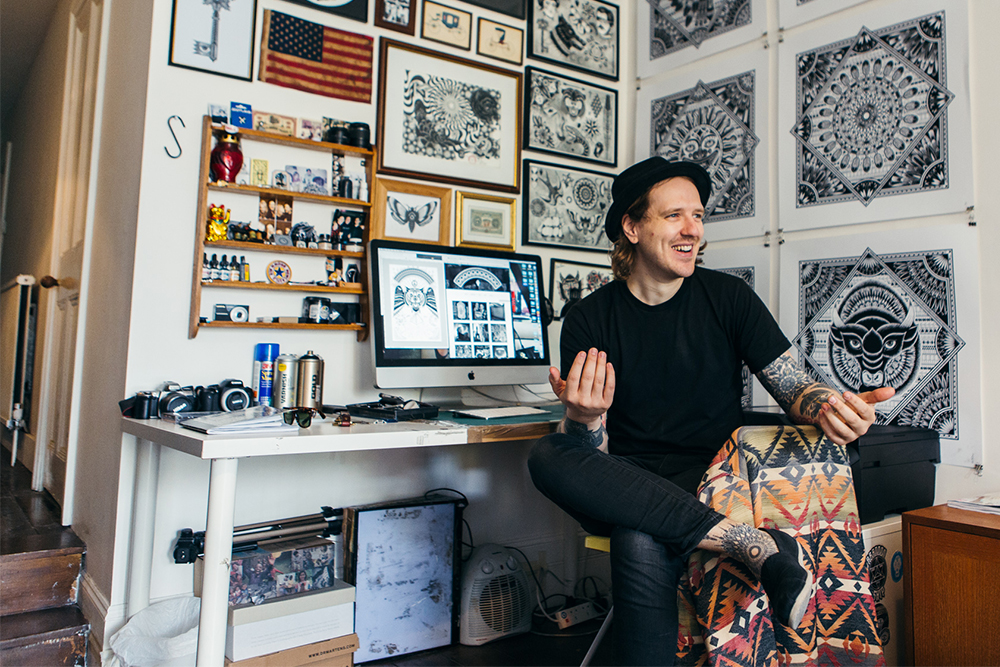
Nah it’s cool man, I’m intrigued!
Okay, this next bit is going to sound ridiculous, but it’s 100% true, I promise! So basically, I was cycling to work at the art shop one day and I hit a pot hole in the road. My bike frame snapped and I had to carry my bike all the way to work from there, and when I eventually arrived at the shop I was two hours late – and I was fired. So, I had my last month’s wages to play with from there and I just hustled, man. I bought some screen-printing equipment and launched this little clothing company, printing everything from the corner of this tiny bedroom that we were living in at the time. That clothing company led on to Parkway Drive seeing my stuff and asking me to design a T-shirt for them, and I didn’t have a clue what to charge them so I just quoted a month’s rent – and they agreed – so I was like, okay, cool... that’s one month done. And it just rolled from there really. Selling T-shirts, starting to take on more work. Just hustling. London allowed me to do all of that.
That’s insane. If we go back to what you were saying before about staying inspired, are there any specific places within the city that you visit to keep your brain working?
There’s a few places. When I’m working on an exhibition, I head to Brick Lane; to places like The Old Truman Brewery and Stolenspace Gallery – just to see how other artists are presenting their work, especially if there’s an artist that I really look up to exhibiting at the time. But then on the other end of that spectrum, I’d go to somewhere like Somerset House or the Tate Britain – to see work from past artists who have been remembered. Like, what do I have to do to achieve that sort of legacy? In the long run, will I just be some guy who’s known for drawing tattoo flash, or will I push some boundaries with my work, and create something that people really remember me for? That’s kinda deep I know, but that’s what keeps me inspired.
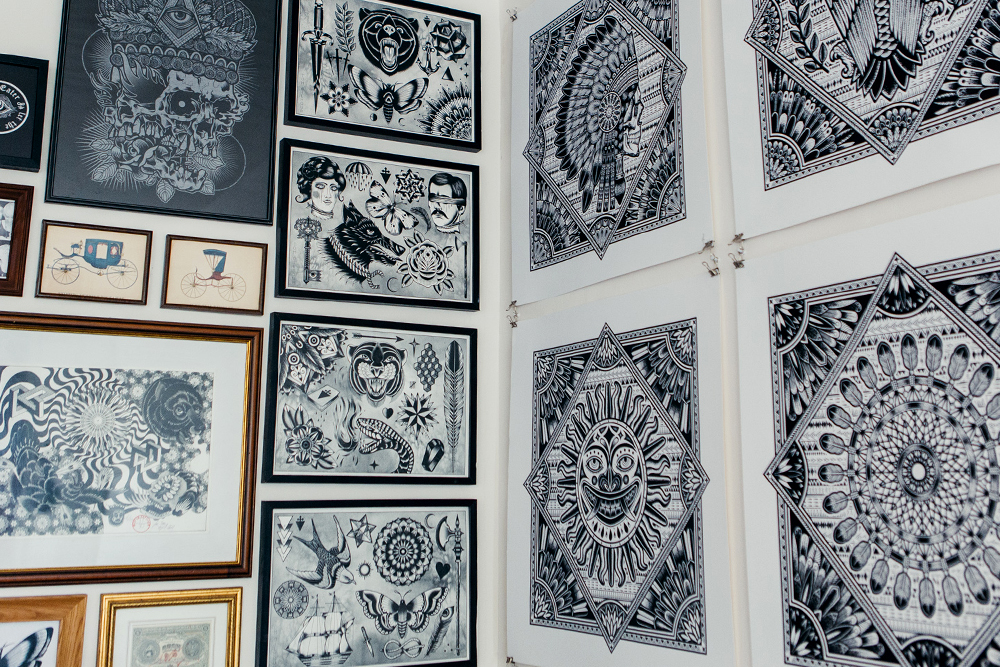
It’s funny that you mentioned tattoo flash there, because I was going to touch upon the influence of tattoo culture that’s very apparent within your artwork. Some people have actually gone as far as getting your artwork tattooed on themselves too, right? So I was wondering, have you ever considered picking up a tattoo gun yourself?
I’ve actually done a few on myself. About two and a half years ago I went over to the South of France to get tattooed by Guy Le Tatooer. I booked three days with him and he did some on my feet, on my arms, on my chest – he’s the sort of artist where you book out a full day at a time. Anyway, before I went over he asked me to bring some of my prints for him, because he really liked my work and he kept saying I should learn to tattoo. I mean, I’ve always loved tattoos but I never wanted to tattoo anyone until I at least felt my work was at a good enough standard. So yeah, fast forward a year from then and Guy sent me an email saying a friend of his was opening a private studio in East London and that I should go speak to him about an apprenticeship. I actually went and worked from there for a couple of months and had a little exhibition and stuff, and that was really cool. That really pushed my drawing standard because people were actually getting this artwork tattooed on them, it had to be the very best I could do.
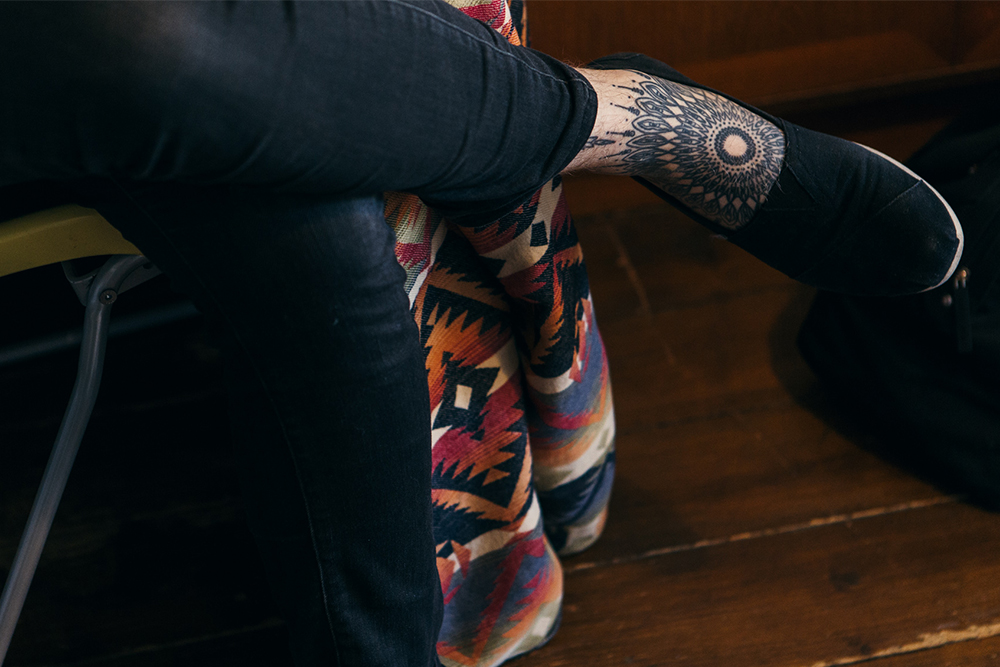
It was around then I got an email about the Mike Giant exhibition in Toronto. So I was at this point where I was at the bottom of the ladder with tattooing and sort of halfway up a ladder with my artwork, and I had to make a choice between the two, really. So I turned down the apprenticeship in London and put my full focus back on my artwork and the Toronto exhibition.
That’s the thing about being a tattoo artist, or an artist in general really, being that if you want reach your full potential you have to put everything you have into it. You’d never want to spread yourself thinly between the two things.
Yeah man, although I’ve got to be honest, that whole tattooist lifestyle was really tempting! Like, once you’ve established yourself and you have the opportunity to fly out to all these different cities for guest spots. NYC, Tokyo, wherever. That would have been amazing – but saying that, in that year I headed out to Canada for that Toronto exhibition, and then I was flown to Paris later in the year for Be Street – and it kinda dawned on me that I can make that all happen through my art anyway.
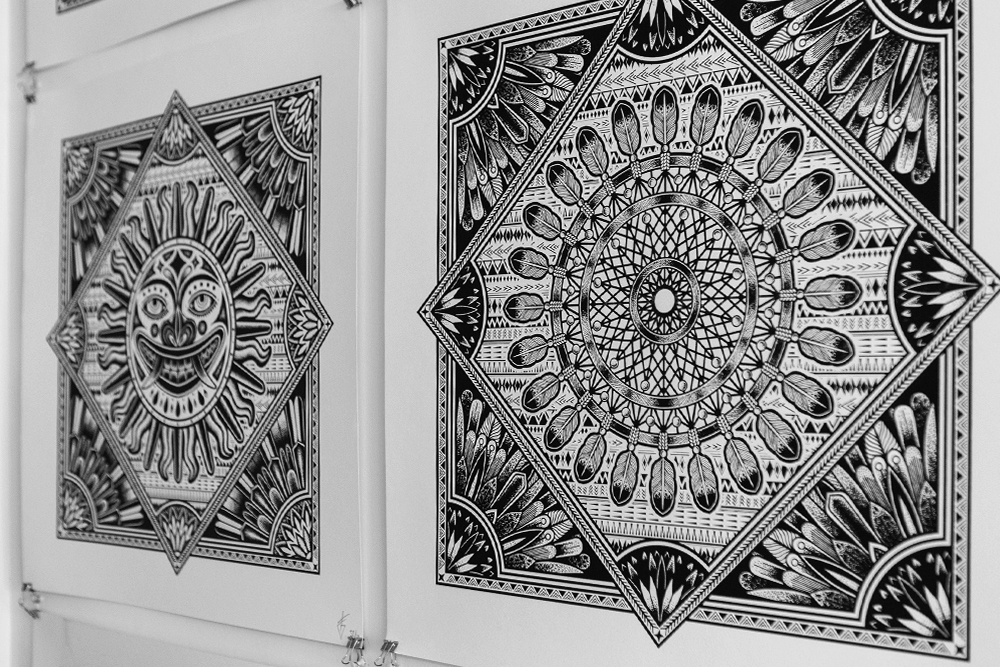
Something I feel a lot of artists struggle with is finding an individual style that they are completely happy with. You’ve developed yours a lot over the years, but would you say you’re content with where you’re at now, or that your style is still evolving?
If I’m 100% honest, I hate this style now. When I put things into perspective, I am obviously very grateful that I can do this for a living, but at the same time I am always trying to find a way of changing it up and move into new areas. There’s things that I’m not fussed about though, like working in colour…
Yeah, I was going to ask you about that. Was that a point blank decision to avoid working in colour, or did it kinda just work out that way?
Well, it first of all stemmed from being inspired by artists like Guy Le Tatooer and Mike Giant – how they work in black and it just comes across as timeless. Almost like newspapers, they’re black and white because that’s the winning formula. Black and white movies, black and white photos – they’ll never not be awesome. But also, when I think of a design in my head, I just never consider the colours. It’s always the outline, the shapes, the shading; and that’s it, done.
There are almost too many options when you bring colour into it, too. There’s a whole spectrum to consider. I think the black and white also plays into the content of your work too — the traditional references. For example, the elements that are inspired by Native American heritage, you couldn’t really pin point when that was drawn, even though you’ve done it in 2015.
That’s another thing I’ve been trying to do actually, in terms of avoiding things that are typically “cool” or on trend, and taking references from obscure places, such as Native America. Obviously I get asked to draw a mandala or a wolf head all the time, but I try and limit repeating myself.
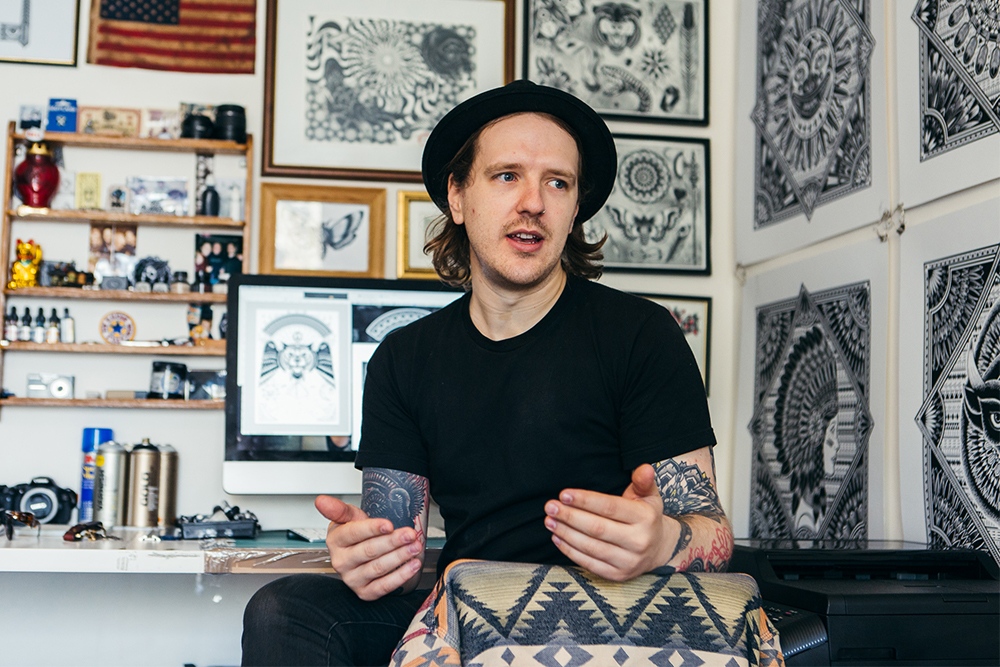
Let’s talk about collaborations for a minute. You recently announced your work with adidas which is a huge look; not just because of it being a global brand, but more because it’s sportswear, which is obviously a huge departure from your traditional roots. So, what experiences did you take away from the project?
The approach was very, very loose. It was kinda just like, “do whatever you want” alongside a very vague moodboard about city life. We hit a few ideas back and forth, and they picked out some of my existing work to explain the sort of thing they were after, until we figured out how to tie that together with the whole city theme. The 1980s city survival guide concept that we settled on took a while to develop, and then we moved onto working with the adidas trefoil logo itself, which was quite limiting as everything had to be within the shape of the logo. But yeah, it was very different to working with a young company. It really was old school, like, everything was handled over the phone. No emails. Even the reference photos they sent over – they had to be posted. It was really weird, actually. Obviously it was a privilege to work for them, though.
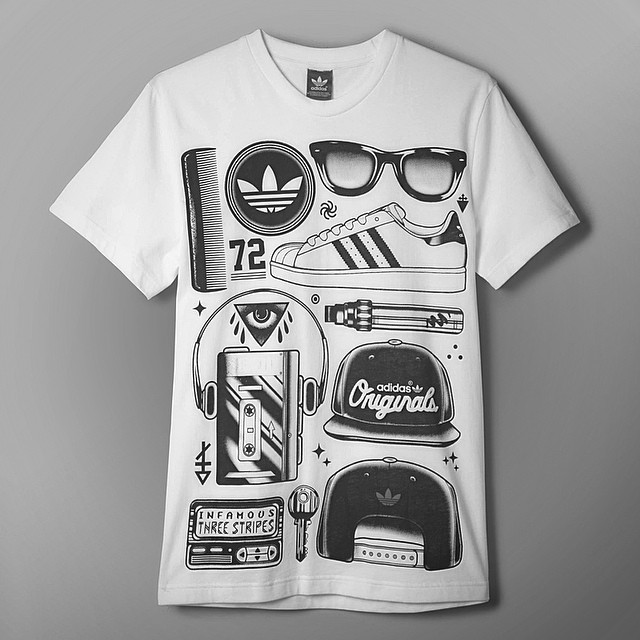
Continuing the theme of collaborations, you touched upon it before, but let’s talk some more about your exhibition with Mike Giant. How did that all come about?
So there’s this guy called Clay who used to live with Mike Giant back in the ’80s and write graffiti with him, and he moved to Toronto to work with a creative agency out there and decided that he wanted to put on an event in this place called the Toronto Brickworks. The whole theme was “versus,” so for example, they had a stage with two DJs playing head-to-head, then all the food was Mexican – so they had a Toronto Taco joint versus a burrito company from Chicago – then there was a long wall which was the old furnace at the brickworks, and that’s where they had all the artwork displayed. There was something like 20 artists, so 10 versus sets of artwork altogether. The funny thing is, I’d never normally pick an artist with an even slightly similar style to collaborate with, but when I got the email with the concept for the show and it included the question “how would you feel about collaborating with Mike Giant?” – that’s just a silly question, really. I mean, of course. I didn’t let that email sit around for a while because I didn’t want another artist to beat me to it.
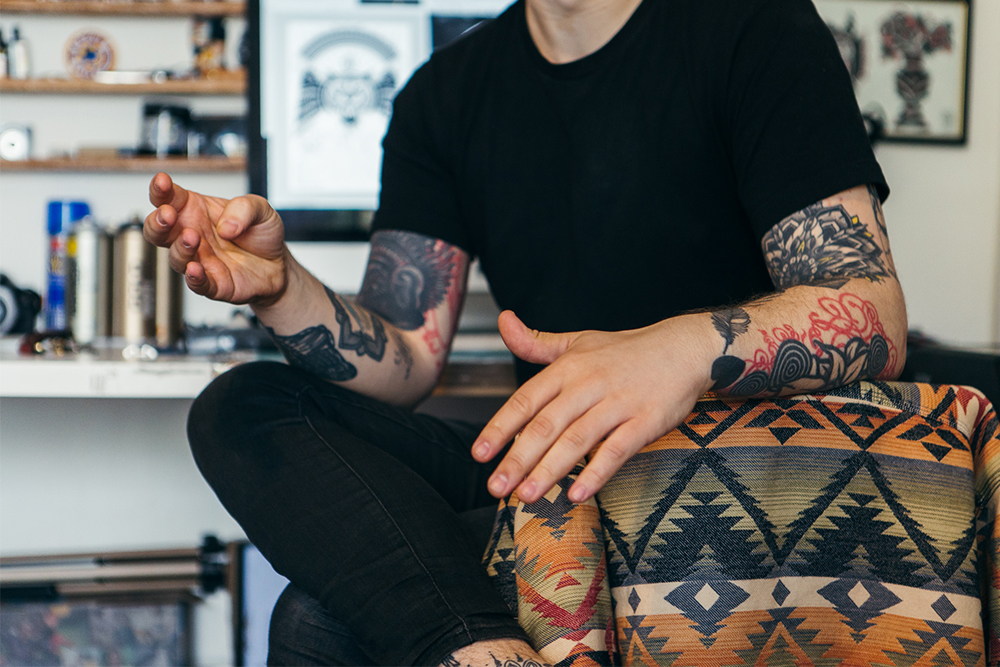
So yeah, that’s how they got in touch, and then I think we had around seven months to come up with the exhibition, so we hit a few emails back and forth and then I put forward the theme of “Rituals’”— so we produced a flash sheet together, with each element having some sort of timeless meaning or history behind it. So yeah, rather than doing something crazy and complicated, we kept it pretty simple. Then when I actually got out to Toronto for the show, that was just insane. There was something like ten thousand people that came. In fact, when we arrived, two of my pieces had already sold and it wasn’t even open yet.
That’s nuts. And you’ve kept in touch with Mike since, right? You’re currently working on something else together?
Yeah man, I mean, it kinda felt silly not to. When you get the opportunity to work with someone like that, you’ve just got to roll with the punches and make it happen. It’s also one of those situations where if you don’t keep it fresh, it might never happen, so I reached out straight away with some other ideas that I had.
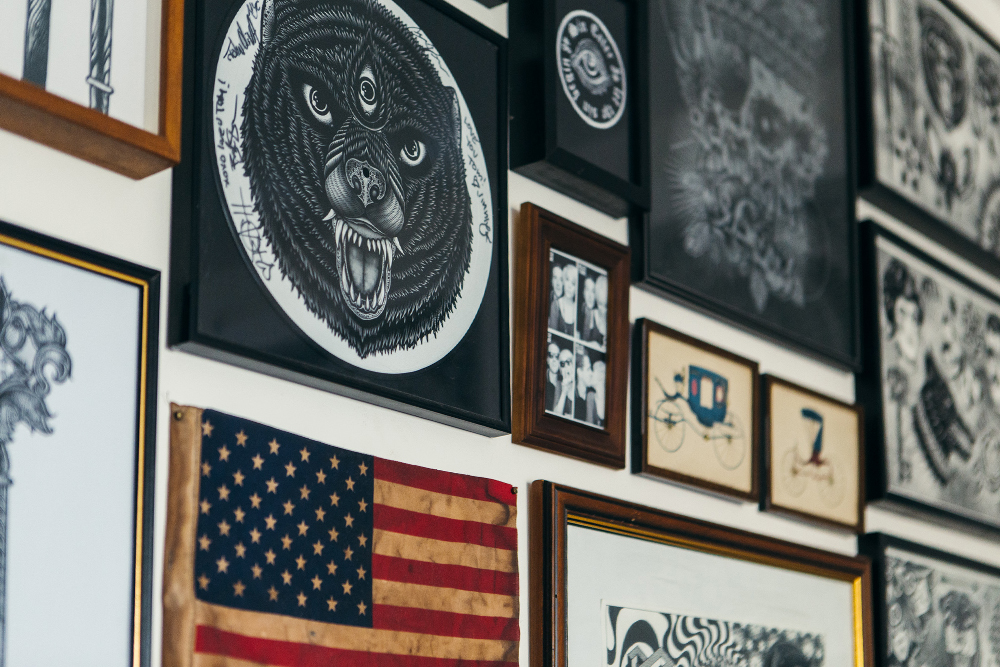
When we spoke before you mentioned a solo exhibition that you’re currently working on. Can you speak a little more about that?
So basically, this woman that has a new gallery space in Santa Monica reached out about me working on exhibition, as she had seen some of my larger mural work on Instagram. So I let her know that I was going to be out there in June anyway, and we’re basically just planning it all around that. I’ve got this rough theme that involves using bronze panels, but there’s not really loads I can tell you because I haven’t finished much of it yet!
And just to wrap things up, are there any other upcoming projects that you’re excited to share?
I’m working on a clothing brand called Parlors with my friend Matt, and that will be launching in the Summer. I actually haven’t told anyone else about that yet, so that’s an exclusive for you. Matt lives in Toronto, but he’s from the USA, so we’re registered as an American company and we’ve got this cool little Toronto / London / NYC dynamic going on.
Long story short, we’ve been wanting to do a brand together for years, but I’ve just been waiting for the right concept to come along. Last year I visited Los Angeles, and went on a trip to Joshua Tree National Park while I was out there. I took a bunch of photos along the way and I came up with this concept whilst looking back over the journey from the city to the desert, which I don’t think anyone else has really done properly before. Also, with the name, we wanted to keep it quite simple and non-specific, but it’s still got the whole American heritage, Western vibe. So yeah, keep an eye out for that.
::
You can stay up to date with Tom Gilmour’s work and travels via his Instagram: @tomgilmourart. Photos by Tom Joy.

